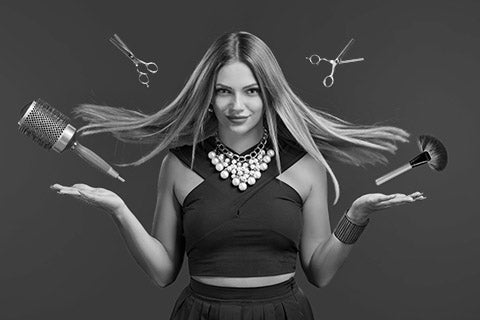The Science Behind Hair Color and Pigmentation
Posted on April 12 2024
Color theory is the foundation of every successful hair coloring technique. It encompasses the scientific principles governing the interaction of light and pigment to create the myriad shades and tones that adorn our clients' locks. As hair professionals, understanding the intricate science behind hair color and pigmentation is paramount to achieving stunning results and meeting the diverse needs of our clientele. In this comprehensive guide, we'll embark on a journey through the fascinating world of color theory, exploring the molecular mechanisms of hair pigmentation, the principles of the color wheel, and the practical applications of this knowledge in the salon.
Understanding Hair Pigmentation
At the core of hair color lies melanin, a complex pigment produced by specialized cells called melanocytes located within the hair follicles. Melanin comes in two primary forms: eumelanin and pheomelanin. Eumelanin, which ranges from black to brown, is responsible for the darker shades of hair color. In contrast, pheomelanin, found in varying concentrations alongside eumelanin, contributes to the lighter hues, including red and blonde tones. The unique combination and distribution of these pigments within the hair shaft determine an individual's natural hair color and underlying tone.
The Role of Melanocytes
Melanocytes are the melanin-producing cells located within the hair follicle bulb. These specialized cells synthesize melanin in response to genetic and environmental factors, including genetics, hormonal fluctuations, and exposure to ultraviolet (UV) radiation. The activity of melanocytes is regulated by a complex interplay of signaling pathways, hormones, and genetic factors, ultimately influencing the pigmentation of the hair shaft.
The Color Wheel A Stylist's Compass
The color wheel serves as a fundamental tool for hair professionals, guiding us in the selection and formulation of hair color. It consists of primary colors (red, blue, and yellow), secondary colors (created by mixing primary colors), and tertiary colors (formed by combining primary and secondary colors). Understanding the relationships between colors—such as complementary, analogous, and triadic—empowers stylists to create harmonious or contrasting color combinations that enhance their clients' features and achieve their desired aesthetic.
Warm vs. Cool Tones
Hair colors can be broadly categorized as warm or cool tones, depending on the underlying pigments present. Warm tones, such as gold, copper, and red, contain hints of yellow, orange, or red pigmentation. These tones infuse warmth and vibrancy into hair color, lending richness and depth to the overall look. In contrast, cool tones, including ash, platinum, and violet, possess blue or green undertones, imparting a cooler, more subdued effect. Identifying whether a client's skin tone is warm or cool guides stylists in selecting the most flattering hair color options and achieving cohesive, balanced results.
Practical Applications of Color Theory
Color theory finds practical application in every aspect of hair coloring, from selecting the appropriate shade to correcting unwanted tones and achieving seamless blends. By leveraging the principles of the color wheel and understanding the nuances of warm and cool tones, hair professionals can customize color formulations to suit their clients' unique preferences and enhance their natural beauty.
Corrective Color Techniques
Corrective color techniques play a vital role in addressing color imbalances, neutralizing unwanted tones, and achieving desired hair color results. Toning, color balancing, and color removal are among the advanced techniques used to correct color discrepancies and refine the overall look. Toning involves the application of a color formula to neutralize unwanted undertones, such as brassiness or yellowing, and restore the hair to its desired shade. Color balancing entails adjusting the overall tone of the hair to create a cohesive and uniform appearance. Color removal techniques, such as color strippers or color reducers, are employed to gently remove or lighten artificial pigment from the hair, allowing for a clean slate and seamless color correction.
Conclusion
Color theory is a multifaceted discipline that merges artistry with science, enabling hair professionals to create customized color solutions that accentuate their clients' natural beauty and individual style. By mastering the principles of hair pigmentation, the color wheel, and corrective color techniques, stylists can navigate the complexities of hair color with confidence and precision, achieving exceptional results in the salon. Embrace the art and science of color theory, and unlock the full potential of your creativity and expertise in the captivating world of hair color.

